75 years of victory in the Kursk Bulge
23 of August in accordance with Federal Law No. 32-FZ of 13 March 1995 of the Year “On the days of military glory (victorious days) of Russia” is celebrated as the Day of Military Glory of Russia - the Day of the defeat of the Nazi troops by the Soviet troops in the Battle of Kursk in 1943 year.
The situation at the front. Party plans
As a result of the winter 1942-1943. the offensive of the Soviet troops and forced withdrawal during the Kharkov defensive operation 1943 was formed the so-called Kursk ledge. The troops of the Central and Voronezh fronts located on it threatened the flanks and rear of the German Army Groups Center and South. In turn, the German groups, occupying the Oryol and Belgorod-Kharkov bridgeheads, had favorable conditions for delivering powerful flank attacks on the Soviet troops defending themselves in the Kursk area. At any moment, the enemy could surround and defeat the Red Army forces there with powerful counter blows.
The German military-political leadership was in a difficult situation. The time of easy victories is over, and the balance of forces on world fronts was not in favor of the Third Reich. As a result, the Germans decided to conduct a major offensive operation in one strategic direction - on the Kursk ledge of the front, and defeat the Soviet troops located here on the Central and Voronezh fronts. This should have led to a general change in the situation on the Eastern Front in favor of the Wehrmacht and the transition of the strategic initiative back into the hands of the German command.
The high command of the enemy believed that after the completion of winter and spring thaw, Soviet troops would continue the offensive. Operational order No. 5 of the Wehrmacht’s headquarters, signed by Hitler on March 13, 1943, spoke about the need to forestall this offensive in certain sectors of the front. In the rest of the local German troops were to "bleed the advancing enemy." The command of Army Group South was supposed to create a strong north of Kharkov in mid-April tank group, and the command of Army Group Center, an attack force in the area south of Orel for an offensive in collaboration with the troops of the northern wing of Army Group South. Order No. 5 scheduled an operation against Leningrad in July by forces of Army Group North.
The Germans began preparations for the offensive, concentrating strong assault groups in the areas of Orel and Belgorod, on the flanks of the Kursk salient. From the north, troops of Army Group Center (the Oryol bridgehead) hung over the ledge, and from the South — troops of Army Group South. 15 on April 1943 of the Wehrmacht was issued operational order number 6, which specifies the tasks of the troops in an offensive operation. The intention of the operation (code name "Citadel") provided for strikes in converging directions from the north and south on the basis of the Kursk bulge on the 4 day of the operation to surround and then destroy the Soviet troops. Subsequently, it was planned to strike at the rear of the South-Western Front (Operation Panther) and launch an offensive in the northeast direction in order to reach the deep rear of the central group of Soviet troops and create a threat to Moscow.
For the operation "Citadel" the best Wehrmacht generals and the most combat-ready troops were involved, additional forces were gathered by regrouping troops from other directions and transferring formations from Germany, France and Norway. Altogether, a total of 50 divisions were concentrated (including 16 tank and motorized divisions) and a large number of separate units included in the 9th and 2nd armies of Army Group Center (Field Marshal G. Kluge), in 4 Tank Army and the Kempf Task Force of Army Group South (Field Marshal E. Manstein). Supported them aviation 4th and 6th air fleets. In total, this group numbered over 900 thousand people, about 10 thousand guns and mortars, up to 2700 tanks and assault guns, about 2050 aircraft. This amounted to about 70% of the tank, up to 30% of motorized and more than 17% of infantry divisions, as well as over 65% of all combat aircraft operating on the Soviet-German front, which were concentrated on a section that made up only about 14% of its length.
In order to achieve rapid success of its offensive, the German command relied on the massive use of armored vehicles (tanks, assault guns, armored personnel carriers) in the first operational echelon. The medium and heavy tanks T-IV, TV ("panther"), T-VI ("tiger") that entered service with the German army, the Ferdinand assault guns had good armor and strong artillery weapons. Their 75-mm and 88-mm guns with a direct shot 1,5-2,5 km in 2,5 times the range 76-mm guns of the main Soviet T-34 tank. Due to the high initial velocity of the projectiles, increased armor penetration was achieved. Armored self-propelled howitzers “Hummel” and “Vespa”, which were part of the artillery regiments of the tank divisions, could also be successfully used for firing direct fire at tanks. In addition, they had excellent Zeiss optics. This allowed the enemy to achieve a certain superiority in tank equipment. In addition, the German aircraft received new aircraft: the Focke-Wulf-190А fighter, the Henkel-190А and Henkel-129 attack aircraft, which were supposed to maintain air supremacy and support the tank divisions.
The German command attached particular importance to the suddenness of the operation "Citadel". For this purpose, it was envisaged to conduct disinformation of the Soviet troops on a large scale. To this end, the intensive preparation of Operation Panther in the South Army Band continued. Demonstrative reconnaissance was conducted, tanks were advanced, transport means were concentrated, radio communications were carried out, agents were activated, rumors were spread, etc. In the band of the army group "Center", on the contrary, everything was carefully camouflaged. But although all activities were carried out with great care and methodicalness, they did not produce effective results.
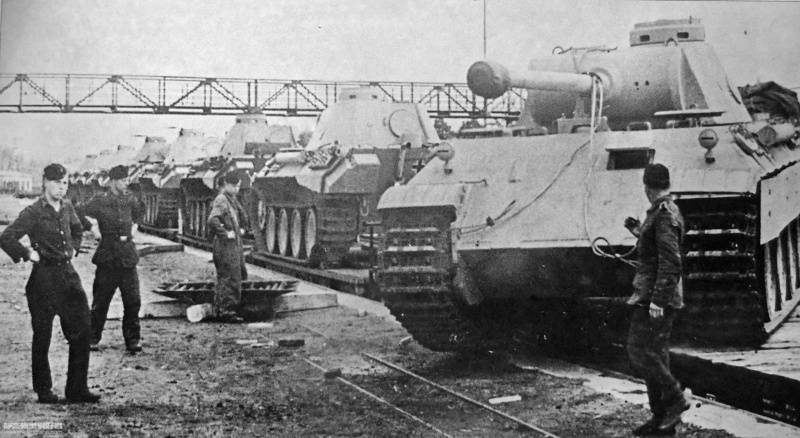
German echelon with tanks "Panther" at the unloading station before the operation "Citadel". Photo source: http://waralbum.ru/
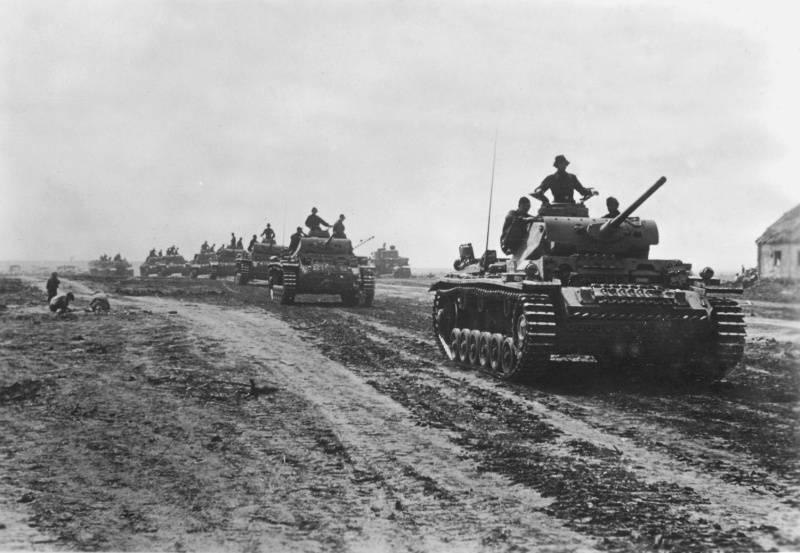
Column of German tanks PzKpfw III on the approach to the front line during operation "Citadel"
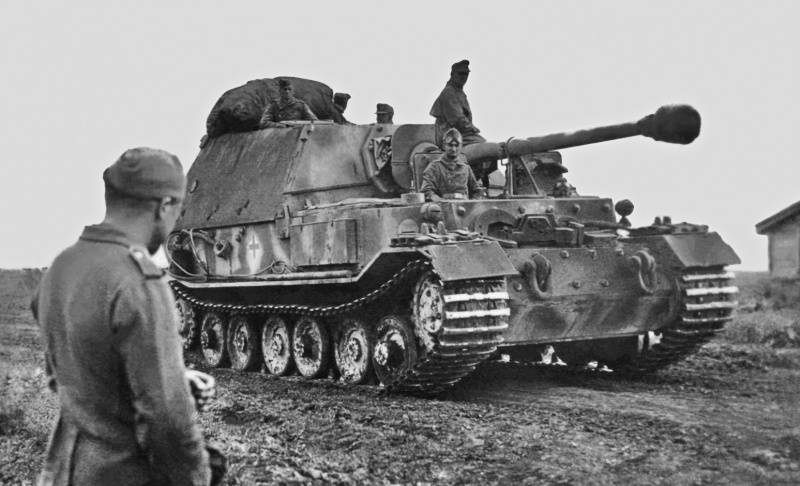
Ferdinand Tank Destroyer Sd.Kfz.184 (8,8 cm PaK 43 / 2 SflL / 71 Panzerjäger Tiger (P) 653-th Battalion of Heavy Tank Fighters (Schwere Panzerjäger-Abteilung 653) in the 19th decade, in the 19th century and in the same period of the design of the tank, in the design of the tank and the tank, they were used in the 19th century and in the same period of the design of the tank on the tactics of the tank battalion Citadel"
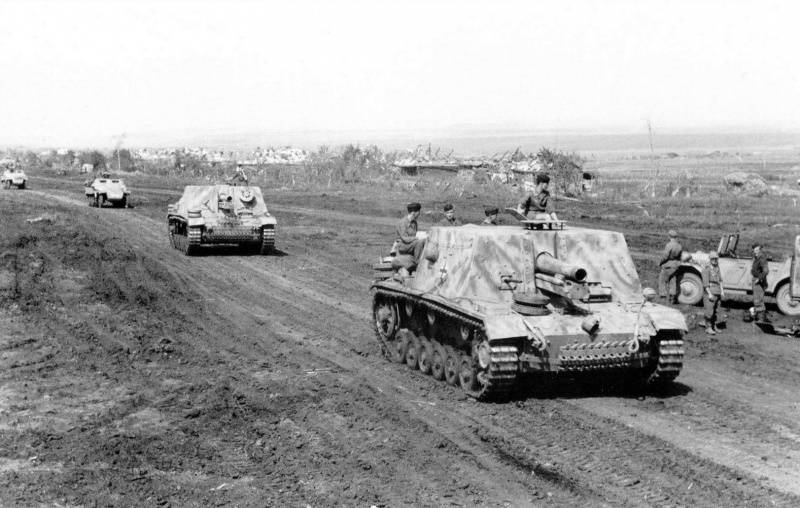
StuG33B assault infantry guns (the first two) of the Wehrmacht’s 23 Panzer Division (23. Pz.Div.) On the march
The Soviet side was also preparing to continue the struggle. The Soviet high command had superiority in manpower and equipment, and everything necessary to preserve the strategic initiative and complete the fundamental turning point in the war. After the end of the winter campaign, the Stake began to prepare in the spring-summer campaign of the year 1943. It was necessary to determine its strategy. It was obvious that the Germans would attack again. But where and when? Therefore, the fronts were instructed to strengthen the defense and prepare the troops for the offensive. Work continued on building strong reserves. Particular attention was paid to intelligence. In early April, Soviet intelligence began to report on the preparation of a major offensive by the Wehrmacht on the Kursk Bulge. It was established and the time of the enemy to go on the offensive.
The Soviet high command faced a difficult task - to choose a course of action: to advance or to defend. Having superiority in forces and means, it was possible to get ahead of the enemy and be the first to strike at the Kursk salient. In his report 8 of April 1943 to the Supreme Commander with an assessment of the general situation and his thoughts on the actions of the Red Army in the summer of 1943 in the Kursk arc, Marshal G.K. Zhukov reported: “I consider the transfer of our troops to the offensive in the coming days with the aim of pre-empting the enemy inappropriate. It would be better if we exhaust the enemy on our defense, knock out his tanks, and then, by introducing fresh reserves, by transferring to a general offensive, we will finally finish off the main grouping of the enemy. ” The same views were shared by the Chief of General Staff A.M. Vasilevsky: “A careful analysis of the situation and the prediction of the development of events made it possible to draw the right conclusion: the main efforts should be concentrated to the north and south of Kursk, bleed the enemy here in a defensive battle, and then go on the counteroffensive and defeat it”. Thus arose the intentional intentional defense with the subsequent transition to the offensive. Not everyone agreed with this decision. Commanders of the Voronezh and Southern Fronts, Generals N.F. Vatutin and R.Ya. Malinovsky insisted on delivering a preemptive strike in the Donbass. They were supported by C.K. Tymoshenko, K.E. Voroshilov and some others.
April 12 held a meeting at Headquarters. On it was made a preliminary decision on deliberate defense, concentrating the main efforts in the area of Kursk, with the subsequent transition to a counter-offensive and a general offensive. The main blow was planned in the direction of Kharkov, Poltava and Kiev. The option of going on the offensive without prior defense was also envisaged, if the enemy would be inactive for a long time. The final decision was made in late May - early June, when it became known about the plan "Citadel". It was envisaged that the offensive grouping of the enemy from the area south of Orel would reflect the Central Front, and from the area of Belgorod - the Voronezh Front. Offensive operations were envisaged to be carried out: on the Orel direction — by the forces of the left wing of the Western Front, Bryansk and Central Fronts (plan of operation “Kutuzov”), on the Belgorod-Kharkov direction — by the forces of the Voronezh, Steppe Fronts and the right wing of the Southwestern Front (operation “Rumyantsev” ).
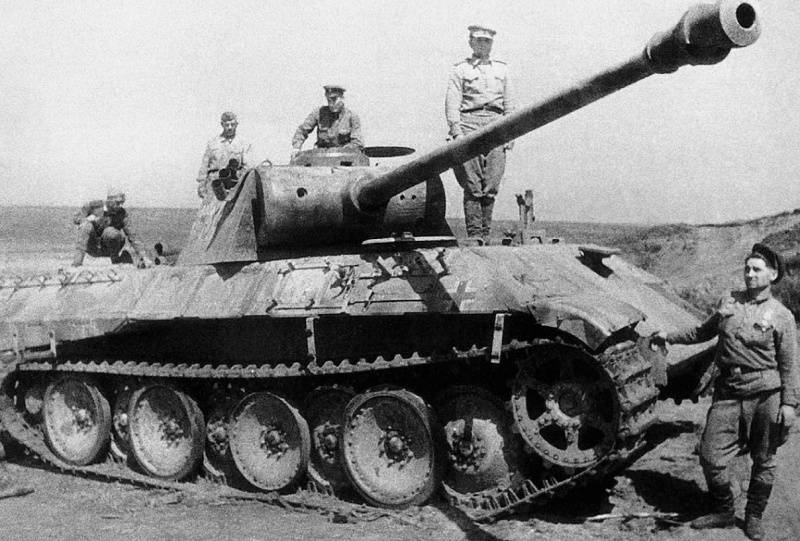
Officers and soldiers of the Red Army on the tank of the Wehrmacht "Panther", captured during the fighting on the Kursk Bulge
In order to withstand the powerful blows of the enemy and exhaust his forces, they prepared in advance a powerful defense. The defensive operation near Kursk involved mainly troops of the Central and Voronezh fronts. The Supreme Command headquarters understood that the transition to deliberate defense was associated with a certain risk of a front breakthrough. Therefore, by April 30, the Reserve Front was formed (hereinafter the military district renamed Steppe, and from July July 9 the Steppe Front). 2-I, 24-th, 53-th, 66-th, 47-th, 46-th, 5-th Guards Tank armies, 1-th, 3-th and 4-th Guards, 3, 10, and 18, tank, 1, and 5, mechanized corps. All of them were stationed in the areas of Kastorny, Voronezh, Bobrovo, Millerovo, Rossosh and Ostrogozhsk. Field control of the front was located near Voronezh. On the orders of the Supreme Command, five tank armies, a number of separate tank and mechanized corps, a large number of rifle corps and divisions were concentrated in the reserve of the Supreme High Command Headquarters (RVGK), as well as in the second echelon of fronts, as directed by the Supreme Command. In the Central and Voronezh fronts received 10 infantry divisions 10 April to July, 10 antitank artillery brigades, 13 separate antitank artillery regiments, artillery regiments 14, eight regiments of the Guards mortars, seven separate tank and self-propelled artillery regiments. Only two fronts were transferred to 5635 guns, 3522 mortar, 1284 aircraft. In total, by the beginning of the Kursk battle, the Central and Voronezh fronts and the Steppe military district consisted of 1909 thousand people, more than 26,5 thousand guns and mortars, over 4,9 thousand tanks and self-propelled artillery systems (SAU), about 2,9 thousand aircraft.
The troops of the Central, Voronezh Fronts and the Steppe Military District created a powerful defense, which included 8 defensive lines and borders with a total depth of 250 – 300 km. The defense was built as an anti-tank, anti-artillery and anti-air with deep separation of battle formations and fortifications, with a widely developed system of strong points, trenches, communication lines and barriers. On the left bank of the Don the state line of defense was equipped. The depth of the defense lines was 190 km on the Central Front, and 130 km on the Voronezh Front. At each front, three army and three front lines of defense, equipped in engineering terms, were created. Both fronts were comprised of six armies: Central Front - 48, 13, 70, 65, 60 combined and 2 tank; Voronezh - 6-th, 7-th Guards, 38-th, 40-th, 69-th combined-arms and 1-th tank. The width of the defense lines of the Central Front was 306 km, and the Voronezh one - 244 km. On the Central Front, all combined-arms armies were located in the first echelon, and four combined-arms armies on the Voronezh side.
The commander of the Central Front, Army General K.K. Rokossovsky, assessing the situation, came to the conclusion that the enemy would strike the main blow in the direction of Olkhovatka in the defense zone of the 13-th All-Arms Army. Therefore, it was decided to reduce the width of the defense zone of the 13 Army from 56 to 32 km and bring its composition to four rifle corps. As a result, the composition of the armies increased to 12 infantry divisions, and its operational structure became two-echelon. Commander of the Voronezh Front, General N.F. Vatutin was harder to determine the direction of the main strike of the enemy. Therefore, the defense zone of the 6 th Guards Combined Arms Army (it was she who defended the direction of the main attack of the enemy's 4 Tank Army) was 64 km. When there were two rifle corps and one rifle division in its structure, the army commander was forced to build army troops in one echelon, allocating only one rifle division to the reserve. Thus, the depth of the defense of the 6 Guards Army initially turned out to be less than the depth of the strip of the 13 Army.
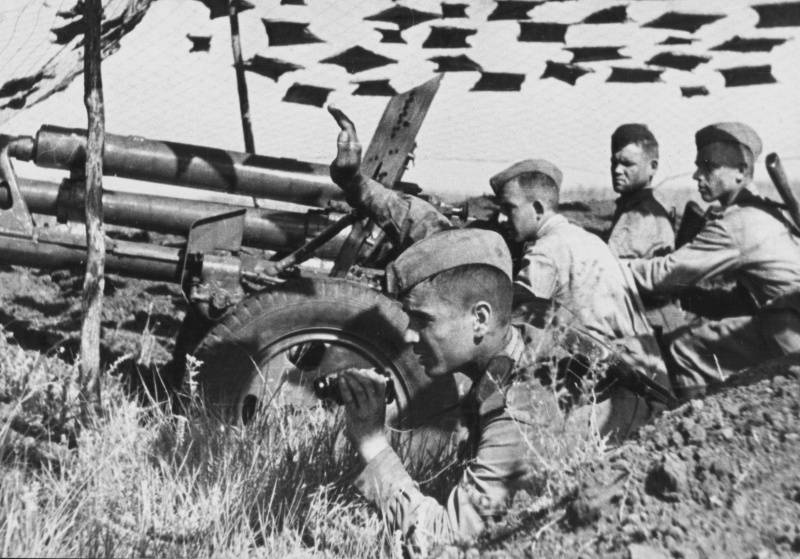
The calculation of the Soviet 76,2-mm divisional gun ZiS-3 is preparing to open fire from a disguised position. 6-I Guard Army
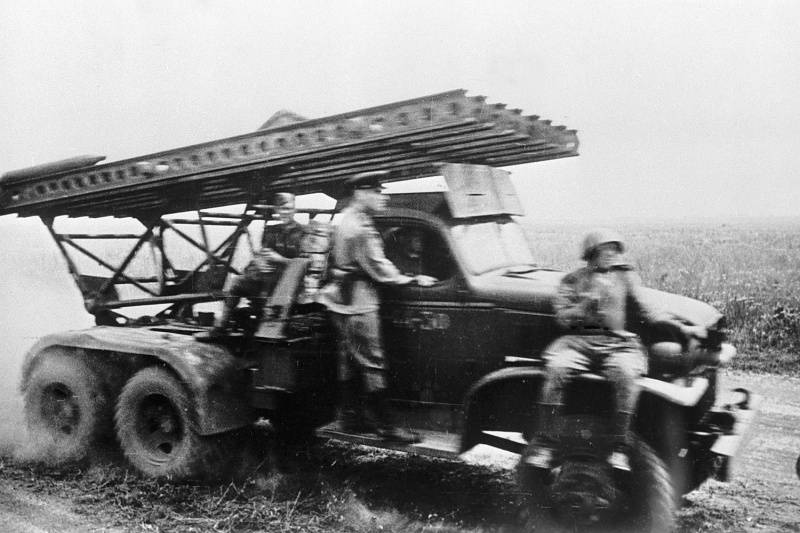
Soviet fighters riding a BM-13 "Katyusha" mortar (on American-made GMC CCKW-352 truck chassis) during the Kursk Bulge fighting
Great importance was attached to the creation of artillery groups. Particular attention was paid to the massing of artillery on the likely directions of enemy strikes. 10 April 1943 issued a special order on the use in battle of artillery of the reserve of the High Command, securing reinforcement artillery regiments to the armies and forming anti-tank and mortar brigades for the fronts. In the defense zones of the 48, 13 and 70 armies of the Central Front, on the intended direction of the main attack of Army Group Center, were concentrated (taking into account the second echelon and reserves of the front) 70% of all guns and mortars of the front and 85% of all artillery RVGK. Moreover, in the 13-th army band, where the point of impact of the main enemy forces was aimed, concentrated 44% of the RVGK artillery regiments. This army, which had 752 guns and mortars in caliber from 76 mm and above, was given an 4 artillery breakthrough, which had 700 guns and mortars and 432 rocket artillery, for reinforcement. This saturation of the army with artillery made it possible to create a density of up to 91,6 guns and mortars on the 1 km of front (including 23,7 anti-tank guns). This density of artillery was not in any of the previous defensive operations.
On the Voronezh front, on the main line, which constituted 47% of the entire front line of defense, where 6-I and 7-I Guards armies stood, they also managed to create a sufficiently high density - 50,7 guns and mortars on 1 km of the front. The 67% guns and mortars of the front and up to 66% of the RVGK artillery (87 from the 130 artillery regiments) were focused on this direction.
The command of the Central and Voronezh fronts paid great attention to the use of anti-tank artillery. They included 10 anti-tank brigades and 40 individual regiments, of which seven brigades and 30 regiments, that is, the vast majority of anti-tank weapons were on the Voronezh front. On the Central Front, more than one-third of all anti-tank artillery weapons became part of the anti-tank artillery reserve of the front, and as a result, the Central Front Commander Rokossovsky was able to quickly use his reserves to fight enemy panzer groups in the most threatened areas. On the Voronezh front, the bulk of anti-tank artillery was transferred to the armies of the first echelon.
Major milestones of the battle. Results
The battle of Kursk continued from July 5 to August 23 1943. 5 July 1943 of the year at 5 in the morning hours in Moscow the Germans began to attack Kursk from Orel and Belgorod, trying to break through the Soviet and Soviet lines from the north and south. For 30-40 minutes before the onset of the enemy offensive, Soviet troops conducted counter attack - the most powerful shelling of the German positions, which greatly weakened the offensive potential of the Nazis. Boil furious battles. By the end of the first day, the Nazis had penetrated into the Soviet military formations to a depth of 3 - 6 km, in two days - on 10 km. However, the Germans could not break through the second line of defense of the 13 Army in the Olhovat area. 7 - July 8 fierce fighting continued. The Germans were able to advance on 3 - 4 km. In the following days, the fighting continued, but the Nazis no longer advanced. For six days of brutal battles, having suffered heavy losses, the Germans wedged into the defense of the Central Front in the zone to 10 km, and in depth - to 12 km. Having exhausted the strike capabilities, the Germans stopped the attacks and went over to the defensive.
The German grouping advancing on Kursk from the south, from the Belgorod region, did not succeed either. This was where the 4 Panzer Army of General Goth and the Kempf Task Force arrived. The enemy attacked the positions of the 6 and 7 of the Guard armies of the generals I.M. Chistyakova and M.S. Shumilova, in the direction of Oboyan and Korochu. On the first day, the Nazis penetrated into the location of the Soviet troops in two narrow areas to a depth of 8 - 10 km. On the night of June 6, Vatutin advanced the 6-th tank army of General M.E. to the second line of defense of the 1-th Guards Army. Katukov. The 2 th and 5 th Guards tank corps were also advanced from the front reserve. 6 July enemy attacks repelled. The counterattacks of the Soviet tank corps made it possible to repel enemy strikes. July 7 The headquarters transferred the 10 tank corps from the Steppe front to the Voronezh front, and the 2 tank corps from the South-Western front. The front aviation was also strengthened. New enemy attacks repelled.
9 July the Germans threw new forces into battle. After the failure of the attack on Oboyan, Manstein decided to send a blow from the 4 tank army to the Prokhorovka area in order to break through to Kursk. The Voronezh Front was again strengthened - they transferred the 5 th Guards Tank and 5 th Guards armies to its structure. They decided to inflict a powerful counter-attack on the enemy. 12 July near the railway station Prokhorovka boil the largest tank battle. On both sides, about 1200 tanks and SPGs participated in it. The German strike, although at a great price, repelled. The defensive battle continued for three more days. For all the time, the German troops penetrated into the location of the Voronezh Front on 35 km.
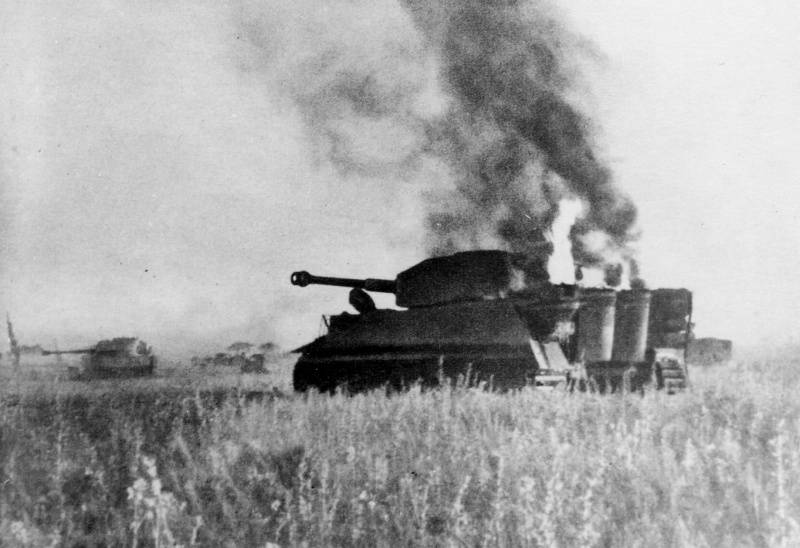
Burning German tank Pz.Kpfw. VI "Tiger" in the field during operation "Citadel"
On July 16, the Germans stopped the attacks and began withdrawing troops to Belgorod. The troops of the left wing of the Voronezh Front and the troops of the Steppe Front entered into battle on 18 in July began to pursue. Opponent repelled Soviet attacks with strong rearguards. By July 23, in general, the position that the Voronezh Front held before the enemy went over to the offensive was restored.
Thus, the defensive battle was completed on the Central Front of July 12, on the Voronezh Front - July July 23. The plan of operation "Citadel" failed. The mobile shock connections of the enemy suffered a defeat. The German command finally lost its strategic initiative. Since that time, the German army largely retreated and defended, although it retained the possibility of strong counter-attacks until the very end of the war.
The pre-prepared Soviet counteroffensive began. On July 12, the Bryansk Front and 11-I Guards Army of the Western Front went on the attack. As a result, the forces of the Bryansk Front, in cooperation with the forces of the Western Front, defeated the Bolkhov grouping of the enemy and liberated Bolkhov on July 29. The forces of the right wing of the Central Front launched an offensive on July 15 in the direction of Krom and July 30, overcoming the strong resistance of the enemy, advanced by 40 km. The Voronezh and Stepnoy Front, after regrouping forces and assets in the Belgorod-Kharkov sector, launched a counter-offensive on August 3. August 5 Soviet troops liberated Orel and Belgorod, August 11 - Hotynets, August 15 - Karachev. The 18 of August troops of the Western, Bryansk and Central fronts dislodged the enemy from the Oryol outcrop and approached the German Hagen defense line east of Bryansk. Oryol operation was successfully completed.
The troops of the Voronezh Front 6 and 7 August freed Grayvoron and Bohodukhiv. The Germans counterattacked, delivered strong blows to the Soviet troops. But the nazis could not radically change the situation. On August 23, the troops of the Steppe Front, with the support of the troops of the Voronezh and South-Western fronts, liberated Kharkov. The giant battle of Kursk is over.
Thus, during the fierce and bloody battle in the area of Kursk, Orel, Belgorod and Kharkov, the Germans suffered a crushing defeat. Our troops drove the enemy westward to 140 — 150 kilometers, liberated Oryol, Belgorod, and Kharkov.
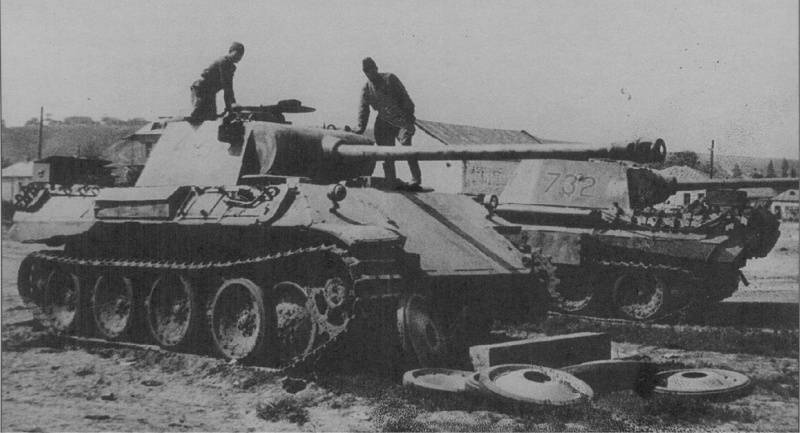
Captured serviceable tanks Pz.Kpfw. V "Panther" on the outskirts of Belgorod
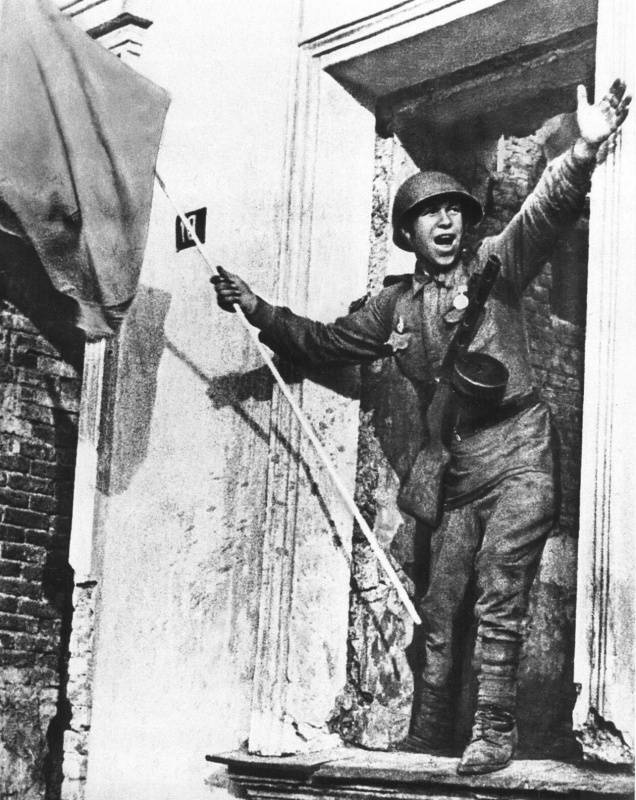
Red Army soldier Malashenko with a banner in the liberated city of Orel (Orel is free!)
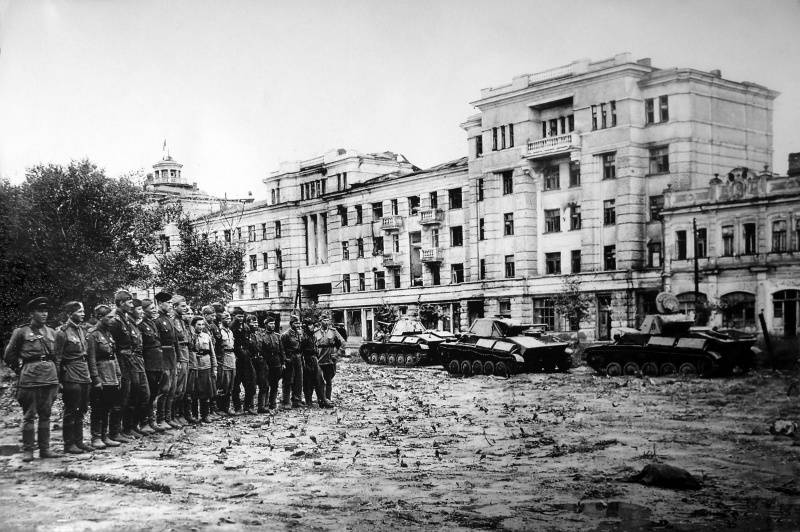
Group portrait of Soviet soldiers in light tanks T-70 in the liberated Orel
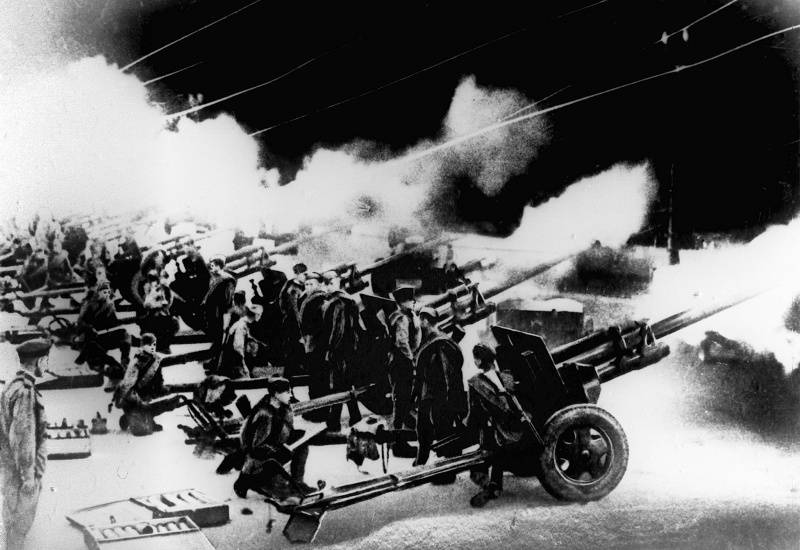
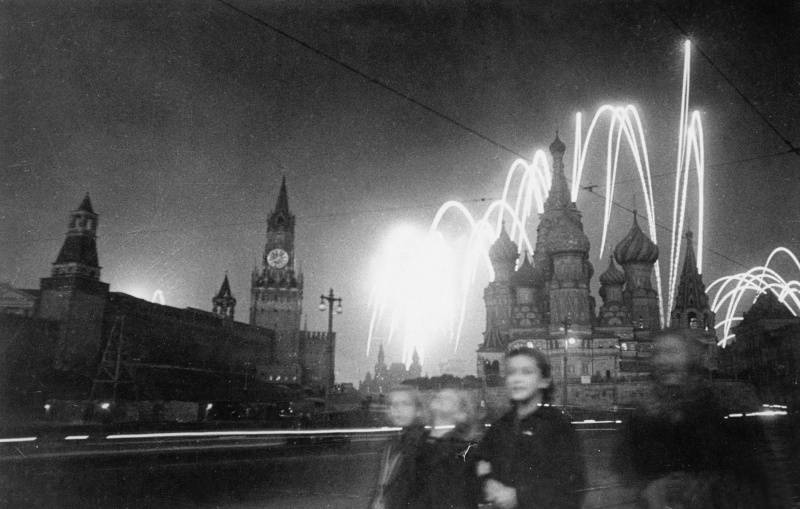
Artillery salute in Moscow in honor of the liberation of Orel and Belgorod
The failure of Operation Citadel buried the hopes of Berlin to take up on the Eastern Front. Field Marshal Manstein subsequently assessed the outcome of the operation: “It was the last attempt to keep our initiative in the East; with its failure, equivalent to failure, the initiative finally passed to the Soviet side. Therefore, Operation Citadel is a decisive turning point in the war on the Eastern Front. ”
Thus, the Battle of Kursk led to a further change in the balance of forces at the front in favor of the Red Army, finally consolidating its strategic initiative and creating favorable conditions for the deployment of a general offensive on a broad front. The rout of the enemy on the “Fiery Arc” completed a radical change in the war and became an important stage in the overall victory of the Soviet Union. Germany and its allies were forced to go on the defensive in all theaters of the Second World War. As a result of the defeat of significant forces of the Wehrmacht on the Soviet-German front, more favorable conditions were created for the deployment of the actions of the US-British troops in Italy, the beginning of the disintegration of the German bloc - the Mussolini regime collapsed.
The Battle of Kursk was one of the biggest battles of the Second World War. On both sides, more than 4 million people were involved in it, over 69 thousand guns and mortars, more than 13 thousand tanks and SPGs, up to 12 thousand aircraft. Soviet troops defeated the 30 divisions (including 7 tank) of the enemy, whose losses were over 500 thousand people, 3 thousand guns and mortars, more than 1,5 thousand tanks and assault guns, over 3,7 thousand aircraft. The losses of the Soviet troops were also heavy: irrevocable - 254 470 people, sanitary - 608 833 people.
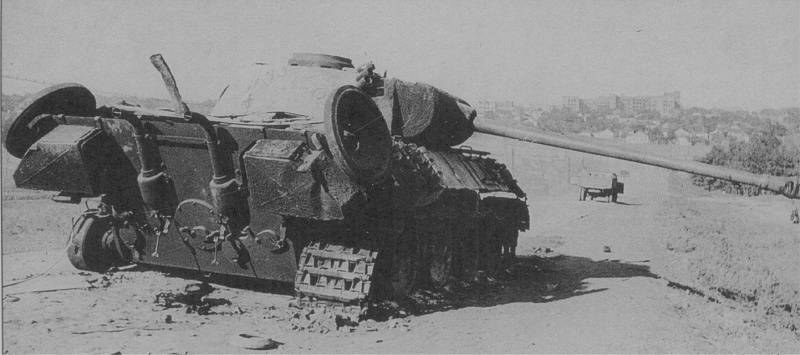
German tank Pz. V "Panther", padded by the calculation of the Senior Sergeant Guard Parfenov on the outskirts of Kharkov
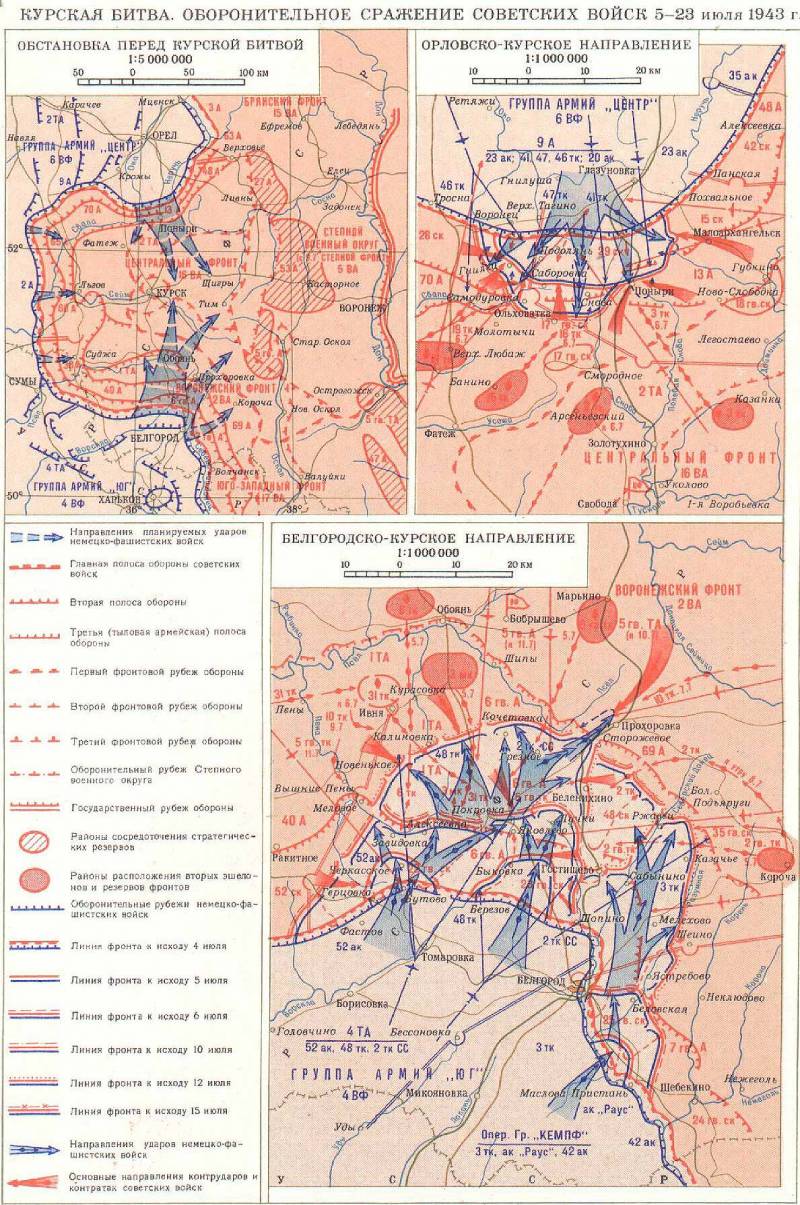
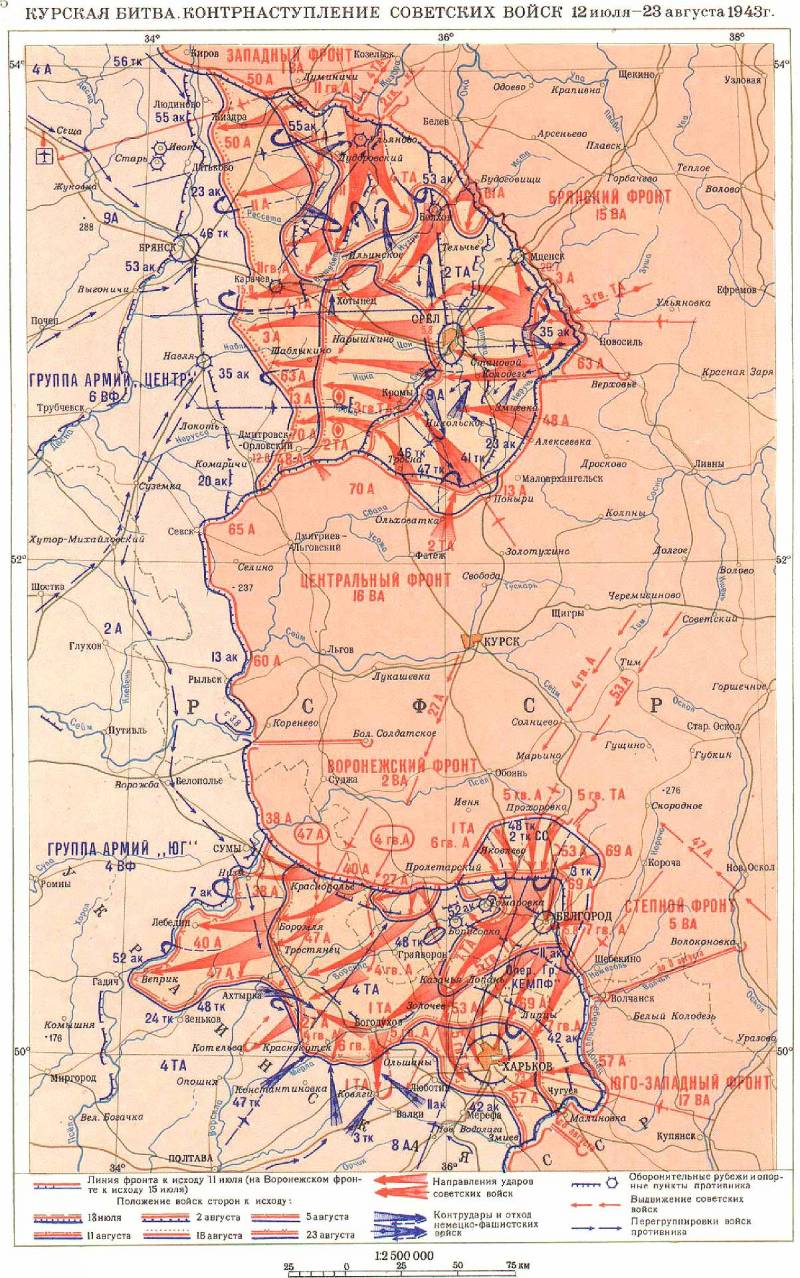
Information